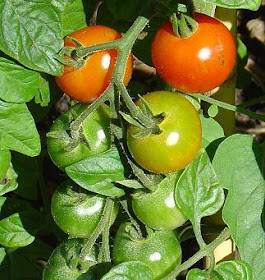Yesterday we talked about where tomatoes come from and today is how to plant them to get the most from your tomato patch:
Tomatoes like loose, fertile
soil. Prepare the garden in the fall by
turning 1 inch (2.5 cm) of good compost and dry leaves into the top 4 inches
(10 cm) of soil. For most growing
regions, it is best to start the tomato early inside, or from purchased
transplants. Sow indoors 4 weeks before
the last frost and transplant after danger of frost.
Start seeds indoors by pressing
moist, potting soil into small planting cells or pots. Using a pencil, drill a small hole in the
soil and sow 3 seeds. Lightly cover the
seeds and place in a window that receives full sun or under growing
lights. Seeds will germinate in 1 to 2 weeks. As they grow they need to be transplanted
into larger, deeper pots. Transplant
before the plant begins to produce flowers.
Tomatoes are a long season crop,
most maturing after 80 days. In cooler
climates tomatoes can be transplanted much earlier, before the last frost date. This takes additional work but will be well
worth the effort. Start seeds indoors 8
weeks before the last frost and transplant 3 weeks before last frost date. One week before transplanting, place a row
cover or Wall-O-Water where the plant will be planted to warm the soil. After planting, water the plant every other
day and fertilize with a nitrogen rich, organic fertilizer to stimulate
growth. If using a Wall-O-Water, be sure
to cover the top on frosty nights by stuffing some newspaper inside.
Plant tomato seedlings 18 to 24
inches (45 to 50 cm) apart in rows spaced 36 inches (90 cm) for optimal
production. When planting, bury the
plant up to the first set of true leaves, or even deeper, depending on the size
of the plant. Place either a cage around
them after removing the row cover, or have posts ready for tying them up. This will help keep vines and tomatoes off
the ground, which is very important to control disease and bugs.
Tomatoes need a lot of water when
they are growing and forming fruits. In
the hot summer months when green tomatoes are on the vine, it is sometimes
necessary to water once in the morning and once at night. If tomatoes begin to split, they may be too
wet. On very hot days, tomato leaves tend
to curl; this is normal unless there are brown spots on the leaves.
Tomatoes need very little
fertilizer if planted in rich soils.
Watch for slow growth, as this may indicate the need for nitrogen. If you do fertilize, do so lightly, as it may
stimulate the plant to grow instead of producing fruits. Also, watch the fruits for brown spots on the
blossom end, called blossom end rot.
This is typically a sign of calcium deficiency or low watering.
After tomatoes begin to blossom it
is good to “stimulate” your plants. Do
this by running your hands through the leaves and gently shaking the
vines. Tomatoes are wind pollinated, and
doing this encourages new flower production and fertilization.

No comments:
Post a Comment
Thank you for leaving a comment, we will review it and post it soon. Happy Gardening!